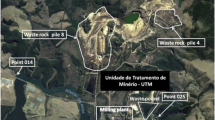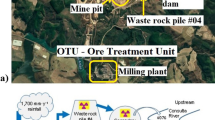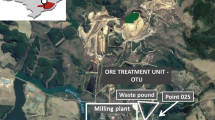Abstract
A mine in an area of naturally occurring radioactive materials (NORM), characterized by acid mine drainage, generates effluents with natural radionuclide concentrations, usually above the limits authorized by the regulator. The plant exploiting NORM controls the water quality and discharges it into the aquatic environment after meeting technical requirements. Downstream, water usage is unrestricted. In order to reach activity concentrations in the released effluents below the authorized values, the facility applies a chemical treatment to the effluent. Then, to ensure the effectiveness of the treatment, the facility performs sampling of treated effluent and determines the activity concentration of natural radionuclides (Unat, 226Ra, and 210Pb from the uranium series and 232Th and 228Ra from the thorium series). In the current study, the proportion and distribution of these radionuclides between the soluble and particulate fractions were determined. The measured activity concentrations were compared with the values proposed by the World Health Organization and Brazilian legislation, as well as other authorities, as regards the potable use from the radioprotection point of view. It was observed that the radionuclides are not in secular equilibrium. The fractions contribute differently to the total release of radionuclide, and there is no linear relationship between the fractions. The average activity concentrations did not result in radiological restrictions to water use, and the committed effective dose due to ingestion was estimated at 0.06 mSv y−1. Therefore, there is no radiological restriction to water use, since the dose which was found was below the constraint value for the public.







Similar content being viewed by others
References
Agbalagba EO, Avwiri GO, Chadumoren YE (2013) Gross α and β activity concentration and estimation of adults and infants dose intake in surface and ground water of ten oil fields environment in Western Niger Delta of Nigeria. J Appl Sci Environ Manag 17(2):267–277. https://doi.org/10.4314/jasem.v17i2.10
Amaral ECS (1982) Modification of exposure to natural radiation due to agricultural and industrial activities in a high natural radioactivity area in Brazil. Ph.D. Thesis. Institute of Biophysics, Federal University of Rio de Janeiro, Rio de Janeiro, p. 130 (in Portuguese)
Amaral ECS, Azevedo HLP, Mendonça AH (1985) Pre-operational environment survey at the uranium mine and mill site, Poços de Caldas, Minas Gerais, Brazil. Sci Total Environ 42:257–266. https://doi.org/10.1016/0048-9697(85)90061-0
Amaral ECS, Godoy JM, Rochedo ERR, Vasconcellos LMH, Pires do Rio MA (1988) The environmental impact of the uranium industry: is the waste rock a significant contributor. Radiat Prot Dosim 22:165–171. https://doi.org/10.1093/oxfordjournals.rpd.a080102
Amaral ECS, Rochedo ERR, Paretzke HG, Penna Franca E (1992) The radiological impact of the agricultural activities in an area of high natural radioactivity. Radiat Prot Dosim 45:289–292. https://doi.org/10.1093/rpd/45.1-4.289
Avwiri GO, Osimobi JC, Ononugbo CP (2016) Gross alpha and gross beta activity concentrations and committed effective dose due to intake of water in solid mineral producing areas of Enugu State, Nigeria. Int J Phys Appl 8:33–43 http://www.irphouse.com/volume/ijpav8n1.htm
Azevedo HLP, Amaral ECS, Godoy JM (1988) Evaluation of the 226Ra transport by river sediments surrounding the Brazilian uranium mining and milling facilities. Environ Pollut 51:259–268. https://doi.org/10.1016/0269-7491(88)90166-2
Barcellos C, Amaral ECS, Rochedo E (1990) Radionuclide transport by Poços de Caldas Plateau Rivers, Brazil. Environ Technol 11:533–540. https://doi.org/10.1080/09593339009384894
Boniolo MR (2016) Uranium removal from waters of acid drainage of mines by biosorption techniques, Ph. D Thesis. UNESP (in Portuguese).https://repositorio.unesp.br/handle/11449/137947
Brasil (1986) CONAMA RESOLUTION n° 1, January 23th 1986. Published in DOU, February 17th 1986, pp 2548–2549. https://www.ibama.gov.br/sophia/cnia/legislacao/MMA/RE0001-230186.PDF
Brasil (2005) RESOLUTION n° 357, March 17th 2005. Published in DOU n° 053, de 18/03/2005. DOU, Brasília, pp. 58–63.http://www2.mma.gov.br/port/conama/legiabre.cfm?codlegi=459
Brasil (2017) Consolidation Joint Ordinance n°5.Brasília: Brazil.Health Ministry, Federal Government (in Portuguese). http://bvsms.saude.gov.br/bvs/saudelegis/gm/2017/prc0005_03_10_2017.html
Cipriani M (2002) Mitigation of social and environmental impacts due to definitive closure of uranium mines. Ph. D Thesis. UNICAMP (in Portuguese). http://repositorio.unicamp.br/jspui/handle/REPOSIP/286971
CNEN - National Commission for Nuclear Energy (1973) Basic standards of radiological protection. pp. 105
CNEN - National Commission for Nuclear Energy (1991) OFÌCIO CNEN – SNU n° 901/91 de 22/07/1991
CNEN - National Commission for Nuclear Energy (1997) Derived limits for the liquid effluent release points of the Poços de Caldas Industrial Complex of the Ore Treatment Unit of the Nuclear Industries of Brazil. Rio de Janeiro, letter n° 050/SLC (in Portuguese).
CNEN - National Commission for Nuclear Energy (2011) Regulatory position 3.01/011. Dose coefficients for public exposure (in Portuguese)
CNEN - National Commission for Nuclear Energy (2014) Norm CNEN-NN-3.01, Basic guidelines for radiological protection. pp. 34
CNEN- National Commission for Nuclear Energy (1988) Norm CNEN-NE-3.01, Basic radioprotection guidelines. pp. 121
Cunha MF (2007) Analysis of the state-of-the-art of a mine closure, in Minas Gerais. M.Sc. Masters dissertation. UFOP. (in portuguese). https://www.repositorio.ufop.br/bitstream/123456789/2668/1/DISSERTA%C3%87%C3%83O_An%C3%A1liseEstudoArte.pdf
EU - European Unione (2013) Council Directive 2013/51/EURATOM of October 22th 2013 on the laying down requirements for the protection of the health of the general public with regard to radioactive substances in water intended for human consumption. Official Journal of the European Communities. http://data.europa.eu/eli/dir/2013/51/oj
Fagundes JR (2005) Water balance of the uranium mine Osamu Utsumi as subsidy for acid drainage remediation projects. Ph.D. Thesis. UFOP. (in Portuguese). http://www.nugeo.ufop.br/uploads/nugeo_2014/teses/arquivos/paginasarquivos-22-66.pdf
Fernandes HM, Veiga LHS, Franklin MR, Prado VCS, Taddei JF (1994) Environmental impact assessment of uranium mining and milling facilities: a study case at the Poços de Caldas uranium mining and milling site, Brazil. J Geochem Explor 52:161–173. https://doi.org/10.1016/0375-6742(94)00043-B
Ferrari RC (2010) Assessment of the environmental consequences due to radioactive effluents from uranium mining on the physical, chemical and diversity characteristics of the zooplankton community. Mineral Treatment Unit, Antas dam and Bortolan dam, Poços de Caldas, MG. M.Sc. Masters dissertation. USP. (in Portuguese). http://www.teses.usp.br/teses/disponiveis/87/87131/tde-24032011-160237/pt-br.php
Ferrari CR, Nascimento HAF, Rodgher S, Almeida T, Bruschi AL, Nascimento MRL, Bonifácio RL (2017) Effects of the discharge of uranium mining effluents on the water quality of the reservoir: an integrative chemical and ecotoxicological assessment. Sci Rep 7. https://doi.org/10.1038/s41598-017-14100-w
Franklin MR (2007) Numerical modeling of the hydrological flow and the geochemical processes applied to the prevision of the acid drainage in a sterile pile of the Poços de Caldas uranium mine - MG. Ph.D. Thesis. UFRJ (in Portuguese). http://www.coc.ufrj.br/en/component/docman/?task=doc_download&gid=873...
Godoy JM, Lauria DC, Godoy M, Cunha R (1994) Development of a sequential method for determination of 238U, 234U, 232Th, 230Th, 228Th, 228Ra, 226Ra and 210Pb in environmental samples. J Radioanal Nucl Chem 182(1):165–169. https://doi.org/10.1007/BF02047980
Grabarczyk M, Koper A (2013) Simultaneous quantification of Bi(III) and U(VI) in environmental water samples with a complicated matrix containing organic compounds. Environ Monit Assess 185:5515–5522. https://doi.org/10.1007/s10661-012-2963-8
IAEA (1996) International basic safety standards for protection against ionizing radiation and for the safety of radiation sources, IAEA Safety Standards Series No. 115. Vienna
IAEA (2002) Management of radioactive waste from the mining and milling of ores, WS-G-1.2
IAEA (2002a) Dispersion of radioactive material in air and water and consideration of population distribution in site evaluation for nuclear power plants
IAEA (2005) Environmental and source monitoring for purposes of radiation protection, Vienna, IAEA
IAEA (2011) Disposal of radioactive waste. Vienna: IAEA
IAEA (2013) Management of NORM residues. Vienna, IAEA
IAEA (2014) Radiation protection and safety of radiation sources: international basic safety standards. IAEA Safety Standards Series No. GSR Part 3. Vienna
IAEA (2016) Criteria for radionuclide activity concentrations for food and drinking water. Vienna: IAEA
IAEA (2018) Radiation protection of the public and the environment. Vienna
IAEA (2018a) Regulatory control of radioactive discharges to the environment, Vienna, IAEA
IAEA (2018b) Prospective radiological environmental impact assessment for facilities and activities, Vienna
ICRP (1977) Recommendations of the international commission on radiological protection. New York: Elsevier
ICRP (1991) Recommendations of the international commission on radiological protection. ICRP Publication 60. New York: ICRP
ICRP (2007) Recommendations of the international commission on radiological protection, n103.New York: Elsevier Science
ICRP (2013) ICRP Publication 119: Compendium of dose coefficients based on ICRP Publication 60 Volume: 42 issue: 4, page(s): 1–130 Article first published online: August 1, 2013; Issue published: August 1, 2013
Jett SE, Bonham AJ (2017) Reusable electrochemical DNA biosensor for the detection of waterborne uranium. Chem Electro Chem:4. https://doi.org/10.1002/celc.201600617
Labidi S, Gharbi S (2018) Dose assessment to members of the public in Tunisia from intakes of some naturally occurring radionuclides in bottled mineral water. Int J Radiat Res 16(3):371–381. https://doi.org/10.18869/acadpub.ijrr.16.2.371
Le CH, Huynh NPT, Nguyen VT, Le QB (2015) Radon and radium concentrations in drinkable water supplies of the Thu Duc region in Ho Chi Minh City, Vietnam. Appl Radiat Isot 105:219–224. https://doi.org/10.1016/j.apradiso.2015.08.033
Lima JC (2014) Characterization of the benthic macroinvertebrates fauna of the Águas Claras dam, Caldas, Minas Gerais. Poços de Caldas, MG. M.Sc. Masters dissertation. UNIFAL (in Portuguese). https://bdtd.unifal-mg.edu.br:8443/handle/tede/617
Lopes JM, Medeiros MPC, Garcêz RWD, Filgueiras RA, Thalhofer JL, Silva Júnior WFR, Silva AX (2018) Comparison of simulated and experimental values of self-absorption correction factors for a fast and credible adjust in efficiency curve of gamma spectroscopy. Appl Radiat Isot 141:241–245. https://doi.org/10.1016/j.apradiso.2018.05.005
Lopes JM, Garcêz RWD, Silva LB, Silva RC, Domingues AM, Silva AX, Dam RSF (2020) Committed effective dose due to consumption of fruits and vegetables peels: analysis on cancer risk increase. Radiat Phys Chem 167:1–6. https://doi.org/10.1016/j.radphyschem.2019.03.047
Lydie RM, Hakam OK, Choukri A (2011) The annual intake and the annual effective dose due to 226Ra and 228Ra in drinking water in Yaoundé area, Cameroon. Global J Environ Res 5:65–69 http://idosi.org/gjer/gjer5(2)11/3.pdf
Merli D, Protti S, Labo M, Pesavento M, Profumo A (2016) A ω-mercaptoundecylphosphonic acid chemically modified gold electrode for uranium determination in waters in presence of organic matter. Talanta 151:119–125. https://doi.org/10.1016/j.talanta.2016.01.032
Murta FC (2006) Column tests for the evaluation of the acid drainage passive remediation for the Osamu Utsumi mine (INB), CALDAS/MG. M.Sc. Masters dissertation. UFOP (in Portuguese). http://www.repositorio.ufop.br/handle/123456789/3264
Nobrega FA (2007) Analysis of multiple-variable for a mine closure - a case of the bf-4 sterile pile from Osamu Utsumi Mine, INB Caldas, MG. M.Sc. Masters dissertation. UFOP (in Portuguese). https://www.repositorio.ufop.br/handle/123456789/4992
NRC (2000) Radionuclides Rule 66 FR 76708 December 7, 2000 Vol. 65, No. 236.Washingthon
Ogundare FO, Adekoya OI (2015) Gross alpha and beta radioactivity in surface soil and drinkable water around a steel processing facility. J Radiat Res Appl Sci 8(3):411–417. https://doi.org/10.1016/j.jrras.2015.02.009
Oliveira PE (2016) Evaluation of the fluvial sediments quality around the Caldas uranium mine. M.Sc. Masters dissertation. UFOP (in Portuguese). http://www.repositorio.ufop.br/handle/123456789/6828
Pedrobom HJ (2016) Uranium speciation in a treated acid drainage from mining using the thin films diffusion technique by concentration gradient. M.Sc. Masters dissertation. UNESP (in Portuguese). https://repositorio.unesp.br/handle/11449/141920
Pereira WS, Kelecom AG, Silva AX, Carmo AS, Py Júnior DA (2017) Assessment of uranium release to the environment from a disabled uranium. J Environ Radioact:180–022. https://doi.org/10.1016/j.jenvrad.2017.11.012
Pivovarova ЕА, Shibaniva NY (2016) Assessment of carcinogenic health risk caused by drinking water intake for population in Khakass Republic. Health Risk Anal 3:44–52. https://doi.org/10.21668/health.risk/2016.3.05.eng
Quesada-Gonzalez D, Jairo GA, Blake RC, Blake DA, Merkoçi A (2018) Uranium (VI) detection in groundwater using a gold nanoparticle/paper-based lateral flow device. Sci Rep 8. https://doi.org/10.1038/s41598-018-34610-5
Rodgher S, Azevedo H, Ferrari CR, Roque CV, Ronqui LB, Campos MB, Nascimento MRL (2013) Evaluation of surface water quality in aquatic bodies under the influence of uranium mining (MG, Brazil). Environ Monit Assess 185:2395–2406. https://doi.org/10.1007/s10661-012-2719-5
Ronqui LB (2008) Limnological characterization and evaluation of environmental effects caused by uranium mine effluents on planktonianmicrobionic populations of the Antas dam (MG). M.Sc. Masters dissertation. USP (in Portuguese). https://www.teses.usp.br/teses/disponiveis/87/87131/tde-11032009-103405/pt-br.php
Rosner B (2000) Fundamentals of biostatistics, Duxbury Thomson Learning ed. 5th edition, 792 pp.
Saha A, Debnath T, Neogy S, Ghosh HN, Saxena MK, Tomar BS (2017) Micellar extraction assisted fluorometric determination of ultratrace amount of uranium in aqueous samples by novel diglycolamide-capped quantum dot nanosensor. Sensors Actuators B Chem 253:592–602. https://doi.org/10.1016/j.snb.2017.06.171
Salviano AB (2010) Evaluation of steel slag for control and diminution of the acid drainage due to mining.M.Sc. Masters dissertation. UFOP (in Portuguese). http://www.repositorio.ufop.br/handle/123456789/2178
Savvin SB (1961) Analytical use of arsenazo III: determination of thorium, zirconium, uranium and rare earth elements. Talanta 8(9):673–685. https://doi.org/10.1016/0039-9140(61)80164-1
Savvin SB (1964) Analytical applications of arsenazo III—II: determination of thorium, uranium, protactinium, neptunium, hafnium and scandium. Talanta 11(1):1–6. https://doi.org/10.1016/0039-9140(64)80003-5
Sethy NK, Jha VN, Sahoo SK, Shukla AK, Tripathi RM, Puranik VD (2011) Ground water ingestion dose due to intake of radionuclide (Natural u and 226 ra) to population around uranium mining complex at Jaduguda. J Ecosyst Ecograph 1:104. https://doi.org/10.4172/2157-7625.1000104
Tawalbeh AA, Samat SB, Yasir MS, Omar M (2012) Radiological impact of drinks intakes of naturally occurring radionuclides on adults of central zone of Malaysia. Malaysian J Anal Sci 16:187–193 http://www.ukm.my/mjas/v16_n2/Tawalbeh.pdf
USEPA 1997 Exposure factors handbook, V. 1, 2, and 3. Washington, D.C.
USEPA 1999 Cancer risk coefficients for environmental exposure to radionuclides. EPA 402-R-99-001. United States Environmental Protection Agency
Wang X, Chen L, Wang L, Fan Q, Pan D, Li J, Chi F, Xie Y, Yu S, Xiao C, Luo F, Wang J, Wang X, Chen C, Wu W, Shi W, Wang S, Wang X (2019) Synthesis of novel nanomaterials and their application in efficient removal of radionuclides. Sci China Chem 62:933–967. https://doi.org/10.1007/s11426-019-9492-4
WHO 2011 Guidelines for drinking-water quality — 4th Ed., WHO, Geneva
WHO 2017 Guidelines for drinking-water quality: fourth edition incorporating the first addendum. Switzerland
WHO 2018 Management of radioactivity in drinking-water. Genève
Wu X, Huang Q, Mao Y, Wang X, Wang Y, Hu Q, Wang H, Wang X (2019) Sensors for determination of uranium: a review. Trends Anal Chem 118:89–111. https://doi.org/10.1016/j.trac.2019.04.026
Xiang Y, Lu Y (2011) Using personal glucose meters and functional DNA sensors to quantify a variety of analytical targets. Nat Chem 3:697–703. https://doi.org/10.1038/nchem.1092
Xiao SJ, Zuo J, Zhu ZQ, Ouyang YZ, Zhang XL, Chen HW, Zhang L (2015) Highly sensitive DNAzyme sensor for selective detection of trace uranium in ore and natural water samples. Sensors Actuators B Chem 210:656–660. https://doi.org/10.1016/j.snb.2015.01.014
Yin JC, Wang YS, Zhou B, Xiao XL, Xue JH, Wang JC, Wang YS, Qian QM (2013) A wireless magnetoelastic sensor for uranyl using DNAzyme-graphene oxide and gold nanoparticles-based amplification. Sensors Actuators B Chem 188:147–155. https://doi.org/10.1016/j.snb.2013.06.100
Author information
Authors and Affiliations
Corresponding author
Additional information
Responsible editor: Georg Steinhauser
Publisher’s note
Springer Nature remains neutral with regard to jurisdictional claims in published maps and institutional affiliations.
Rights and permissions
About this article
Cite this article
de Souza Pereira, W., Kelecom, A., Lopes, J.M. et al. Evaluation of the radiological quality of water released by a uranium mining in Brazil. Environ Sci Pollut Res 27, 36704–36717 (2020). https://doi.org/10.1007/s11356-020-09672-6
Received:
Accepted:
Published:
Issue Date:
DOI: https://doi.org/10.1007/s11356-020-09672-6




